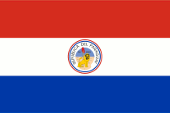
1842–1954,
National flag, reverse,
ratio = 2:3,
Source, by: Flags of the World



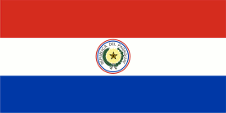
1854–1988,
National flag, obverse,
ratio = 1:2,
Source, by: Flags of the World



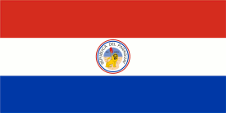
1854–1988,
National flag, reverse,
ratio = 1:2,
Source, by: Flags of the World



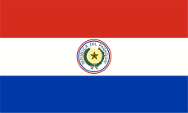
1988–1990,
National flag, obverse,
ratio = 3:5,
Source, by: Flags of the World



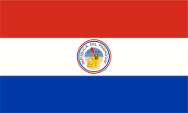
1988–1990,
National flag, reverse,
ratio = 3:5,
Source, by: Flags of the World



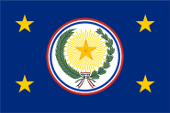
to 1990,
Flag of the President,
ratio = 2:3(?),
Source, by: Flags of the World,
Flaggenbuch 1939



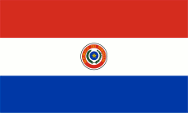
1990–2013,
National flag, obverse,
ratio = 3:5,
Source, by: Flags of the World





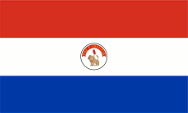
1990–2013,
National flag, reverse,
ratio = 3:5,
Source, by: Flags of the World



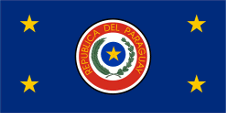
1990–2013,
Flag of the President,
ratio = 1:2,
Source, by: Flags of the World




The today’s flag of Paraguay was officially introduced on 27th of November in 1842 and in the years 1954, 1988, 1990 and 2013 merely changed in the side ratio or in the into the middle of the flag placed seal. It is one of the few flags in the world where the front and the reverse of the flag are different. The flag shows three horizontal stripes in red, white and blue. In the middle of the white stripe is placed on the one side of the flag the coat of arms (seal) of the state and one the other side the seal of the ministry of finance. The colours of the flag are defined by law from 1842, but only as red, white and blue, without specifying more precisely. Today's colours seem to be defined from practice: Red = HEX #D52B1E, which would correspond to Pantone 1795, Blue = HEX #0038A8, which would correspond to Pantone 661. On 25th of May in 1810 was overthrowed in La Plata (where Paraguay at that time belonged) the Spanish Vice-King. It was a bleak and cloudy day on which the roof of clouds suddenly splited and the sun began to shine. That miracle became then renowned in the later Argentina as "Sol de Mayo" (May-Sun) and immortalized on the flag of that country. The proclamation of the independence of Paraguay ought initially be executed on the 14th of May in 1811. A datum in May! Nearly one year after the incidents in Argentina! To let appear a "miracle" in Paraguay too, was predicted a brightly shining star for the night before the 14th of May in 1811. Anyway was hoistet on 14th of May in 1811 a single-coloured blue flag with a white six-pointed star in the upper staff quadrant for the independent Paraguay. This star became now known as "Estrella de Mayo" (May-Star). But the really independence from Spain (and from La Plata too) was proclaimed not until the 17th of June in 1811 as the congress constituted for the first time. There were showed a lot of flags, hoisted and used. It were mostly flags with three horizontal stripes in the colours green, white and blue or red, yellow and blue (colours of Spain added by blue). The patriot, freedom fighter and later head of state Dr. José Rodríguez Gaspar da Francia preferred a flag in the colours red, white and blue. He had deliberately chosen the colours of France as a revolutionary model and an horizontally striped flag in these colours was adopted as the flag of Paraguay on 15th of August in 1812. The white stripe was widened, probably to have enough space for a coat of arms to be placed later. In 1826, Dr. Francia reactivated the solid blue flag with the star in the top corner, supposedly in light blue, however the indigo used to dye the colour blue will have done what it always does, it will have washed out. What the motive was for reintroducing the 1811 flag is unknown. However, the red, white and blue flag also continued to be used, and with the Flag Law of 1842, with stripes of equal width, it was finally reaffirmed as the sole flag of Paraguay. The law, which in principle still applies until today, then stipulated that the seal of the state is to be be placed in the middle of the white stripe, but the seal of the fiscal administration is to be used on the back side of the flag. Since the seal was only described in the law and not depicted, there were many different versions until a standard gradually emerged.
Source:
Flaggen Wappen Hymnen,
Flaggen und Coat of arms of the Welt,
Die Welt der Flaggen,
Volker Preuß

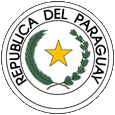
since 2013,
Coat of arms (seal) of Paraguay,
Source, by:
Wikipedia (DE)
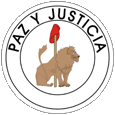
since 2013,
Seal of the Ministry of Finance,
Source, by:
Wikipedia (DE)
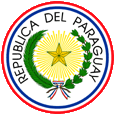
1842–1990,
Coat of arms (seal) of Paraguay,
Source:
Corel Draw 4,
Wikipedia (DE)
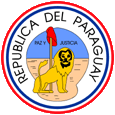
1842–1990,
Seal of the Ministry of Finance,
Source:
Corel Draw 4,
Wikipedia (DE)
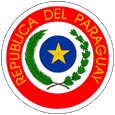
1990–2013,
Coat of arms (seal) of Paraguay,
Source:
Wikipedia (DE)
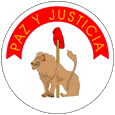
1990–2013,
Seal of the Ministry of Finance,
Source:
Wikipedia (DE)

The coat of arms of Paraguay is actually a seal. It has its roots in the by Dr. José Rodríguez Gaspar da Francia used seal. That showed two crossed palm fronds. In 1821 was added the "May-Star" into the seal and one palm frond was substituted by an oil twig. The both twigs stand for peace and honor. The name of the country ("REPUBLICA DEL PARAGUAY") also appears in the seal. In the year 1990 the seal was changed a little bit. The "May-Star" was placed on a blue disk and the rays of the star were removed, just as the red-white-blue ribbon which held the twings until that point in time. The name of the country was placed golden on a red around placed banner. The outermost border is not more designed in the colours red, white and blue, but is formed by a simple black line. The seal of the ministry of finance – which is placed on the reverse of the flag – shows a lion which guards a Phrygian cap. These symbols stand for peace and justice and for its defense. The seal was also changed in 1990. The colored background and the name of the country were removed and the lion looks now in the other direction. The motto "Paz y Justicia" (Peace and Justice) was placed within an in the upper half positioned red ribbon. The Seal of the State and the ministry of finance were changed again in July 2013.
Source:
Flaggen Wappen Hymnen,
Flaggen und Coat of arms of the Welt,
Die Welt der Flaggen,
Wikipedia (ES),
Volker Preuß


Aircraft Roundel,
Source, by: Wikipedia (EN)

Location:
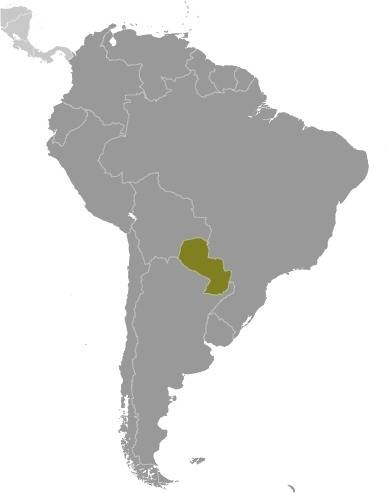
Source: CIA World Factbook
Map of the country:
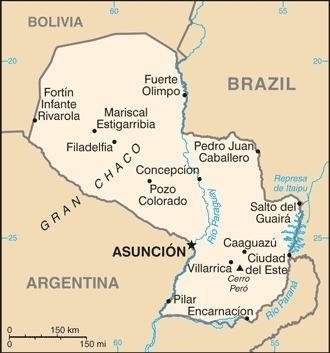
Source: CIA World Factbook

Area: 157.047 square miles
Inhabitants: 7.100.000 (2020), thereof 74% Mestizos, 20% Europeans (including approx. 500.000 Germans and of German descent), 3% Mulattoes, 2% Indians (Guaraní), 0,5% Asians
Religions: 90% Roman Catholic, 7% Protestant, 1% other Christian
Density of Population: 45 inh./sq.mi.
Capital: Asunción, 525.000 inh. (2016)
official Languagen: Spanish, Guaraní
other Languages: Portuguese, German, English, native Indian languages
Currency: 1 Guaraní (PYG, G) = 100 Céntimos
Time Zone: GMT – 4 h
Source:
Wikipedia (D),
Wikipedia (ES)

Stone Age · Indian settlement of the today's Paraguay, in the east Tupí-Guaraní tribes, in the west (Chaco) Aruak, Guaicurú, Mataco-Mataguayo, Chamacoco, Angaite and Lengua
1524 · discovery of the today’s Paraguay by Alejo García during a traversing of the Chaco, an inhospitable plain
1526 · expedition of Sebastiano Caboto, an Italian seafarer in English service, along the Paraná River, foundation of a smallholding
1537 · foundation of Fort Asunción by Spanish conquerors, formation of the Spanish colony Río de la Plata, trail of the conqueror Juan de Ayola to the east
1542 · trail of the conqueror Irala from Buenos Aires via Asunción to the east
1543 · trail of the conqueror Cabeza de Vacas to the east
1588 · the Jesuit Order establishes in the south of the today’s Paraguay a Christian-Theocratic Indian's State
1617 · the today’s Paraguay becomes separated from the Colony of Río de la Plata and annexed as province to the Spanish Vice-Kingdom of Peru
1725/1733 · protests of Spanish landowners against the Jesuit Order
1750 · Treaty of Madrid, ceding of the Indian State of the Jesuits to Brazil
1753–1756 · Guaraní Wars, a by the Jesuits supported revolt of the Guaraní Indians against Brazil and Spain
1767 · expulsion of the Jesuits out of Paraguay by Spain
1776 · establishment of the Spanish Vice-Kingdom of Río de la Plata (today’s Bolivia, Paraguay, Uruguay, Northern Argentina, Northern Chile, and the Brazilian federal state of Rio Grande do Sul) by separation from the Vice-Kingdom of Peru
17th of June 1811 · declaration of the independence from Spain
12th of October 1813 · proclamation of the republic, in this way irrevocable independence from La Plata (Argentina)
1842 · the independence of Paraguay becomes recognized by Spain and Argentina
1864–1870 · war of Argentina, Brazil and Uruguay (supported by France and Great Britain) against Paraguay, defeat of Paraguay, loss of 4/5 of the population and huge parts of its territory
1932–1935 · Chaco War of Paraguay against Bolivia, 130 000 casualties, Bolivia cedes 2/3 of the Chaco to Paraguay
1940 · establishment of the military dictatorship by Estigarribia and Morínigo
1947 · civil war
1948 · presidial constitution
1954 · establishment of the military dictatorship by Alfred Stroessner
1989 · military coup d’état by Rodriguez
1991 · presidial constitution
1996 · attempted coup d’état by General Oviedo Silva
2000 · attempted coup d’état by supporters of Generals Oviedo Silva
Source:
Atlas zur Geschichte,
Weltgeschichte,
Wikipedia (D)

The country Paraguay has its name tooken over from the same called river. That streams from north to south through the country and flows near the frontier to Argentina into the Paraná River. The name of the Paraguay River is of Indian origin, "para" means "water" and "gua" means "big". "Paraguay" is in this way to translate as "larger becoming water". Probably a hint for the in the mouth area of the river existing swamps.
Source: Handbuch der geographischen Namen


![]()

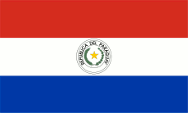
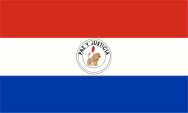

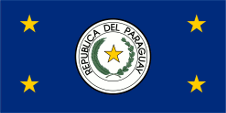
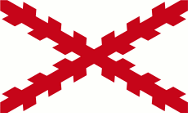


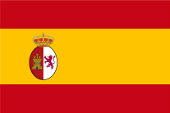
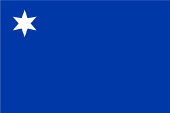
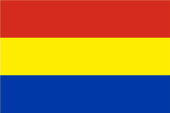
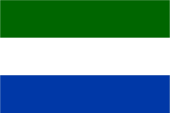
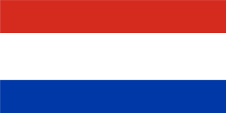

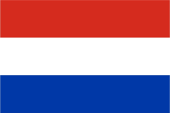
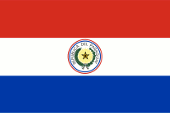




















![]()
